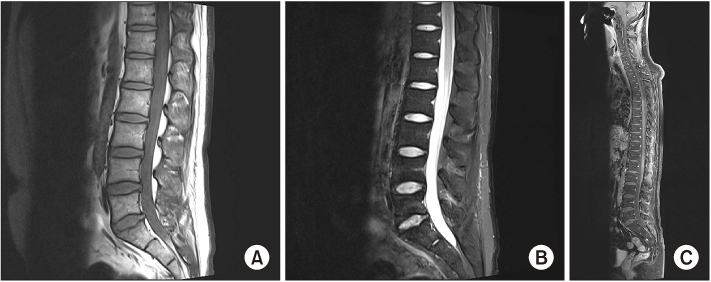J Korean Foot Ankle Soc.
2019 Sep;23(3):131-134. 10.14193/jkfas.2019.23.3.131.
Stiff-Person Syndrome: Diagnostic Difficulty
- Affiliations
-
- 1Department of Orthopedic Surgery, Chungnam National University School of Medicine, Daejeon, Korea. gs1899@hanmail.net
- KMID: 2458015
- DOI: http://doi.org/10.14193/jkfas.2019.23.3.131
Abstract
- Stiff-person syndrome is a rare disorder, and the natural history of the syndrome has not been completely ascertained. The symptoms range from mild to severe and can progress over time: the final result can be significant disability. However, this syndrome is often misdiagnosed due to a lack of understanding of the clinical manifestations. We report the case of a patient who presented with slowly progressing gait disturbance and lower extremity pain and was later diagnosed as suffering from stiff-person syndrome. The patient experienced symptomatic improvement after the administration of benzodiazepines. No recurrence of symptoms has been reported. If the characteristic clinical features and electromyography findings of the syndrome are accurately interpreted, diagnosis of patients with abnormal muscle tension can be effectively done.
Keyword
MeSH Terms
Figure
Reference
-
1. Meinck HM, Thompson PD. Stiff man syndrome and related conditions. Mov Disord. 2002; 17:853–866. DOI: 10.1002/mds.10279.
Article2. Moersch FP, Woltman HW. Progressive fluctuating muscular rigidity and spasm (“stiff-man” syndrome); report of a case and some observations in 13 other cases. Proc Staff Meet Mayo Clin. 1956; 31:421–427.3. Henningsen P, Meinck HM. Specific phobia is a frequent non-motor feature in stiff man syndrome. J Neurol Neurosurg Psychiatry. 2003; 74:462–465. DOI: 10.1136/jnnp.74.4.462.
Article4. Thompson PD. The stiff-man syndrome and related disorders. Parkinsonism Relat Disord. 2001; 8:147–153. DOI: 10.1016/S1353-8020(01)00029-3.
Article5. Murinson BB. Stiff-man syndrome: GABA, GAD, and mechanisms of disease. Neuroscientist. 2000; 6:147–150. DOI: 10.1177/107385840000600304.
Article6. Helfgott SM. Stiff-man syndrome: from the bedside to the bench. Arthritis Rheum. 1999; 42:1312–1320. DOI: 10.1002/1529-0131(199907)42:7〈1312::AID-ANR2〉3.0.CO;2-W.
Article7. Barker RA, Revesz T, Thom M, Marsden CD, Brown P. Review of 23 patients affected by the stiff man syndrome: clinical subdivision into stiff trunk (man) syndrome, stiff limb syndrome, and progressive encephalomyelitis with rigidity. J Neurol Neurosurg Psychiatry. 1998; 65:633–640. DOI: 10.1136/jnnp.65.5.633.
Article8. Choi HY, Sung DH. Stiff-man syndrome: a case report. J Korean Acad Rehabil Med. 2007; 31:232–237.9. Vicari AM, Folli F, Pozza G, Comi GC, Comola M, Canal N, et al. Plasmapheresis in the treatment of stiff-man syndrome. N Engl J Med. 1989; 320:1499. DOI: 10.1056/NEJM198906013202220.
Article10. Brown P, Marsden CD. The stiff man and stiff man plus syndromes. J Neurol. 1999; 246:648–652. DOI: 10.1007/s004150050425.
Article
- Full Text Links
- Actions
-
Cited
- CITED
-
- Close
- Share
- Similar articles
-
- A Case of Stiff-Limb Syndrome Associated with Anti-GAD65 Antibody
- A Case of Paraneoplastic Stiff-Person Syndrome Presenting Multiple Somatic Symptoms
- A Case of Stiff-Man Syndrome Associated with Panhypopituitarism
- A Case of Paraneoplastic Stiff-Person Syndrome Associated with Breast Cancer
- A Case of Successful Treatment for Stiff Man Syndrome



